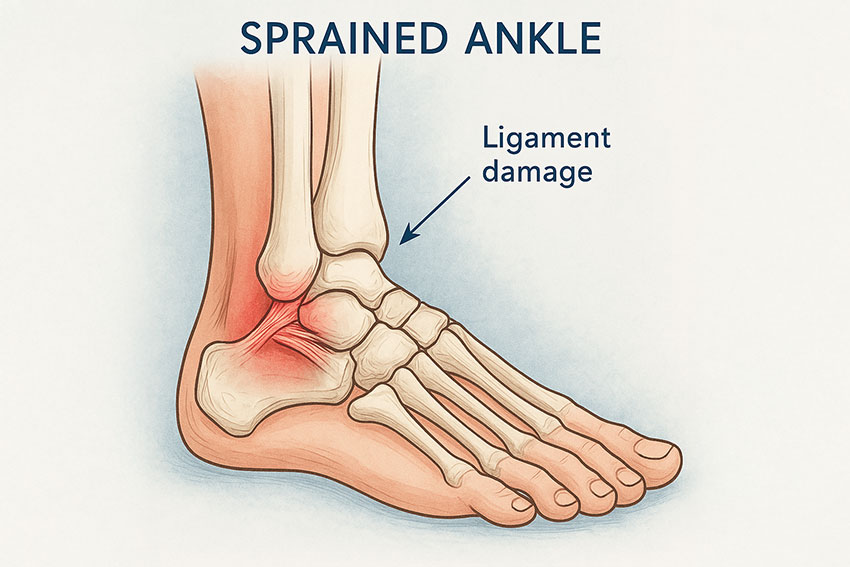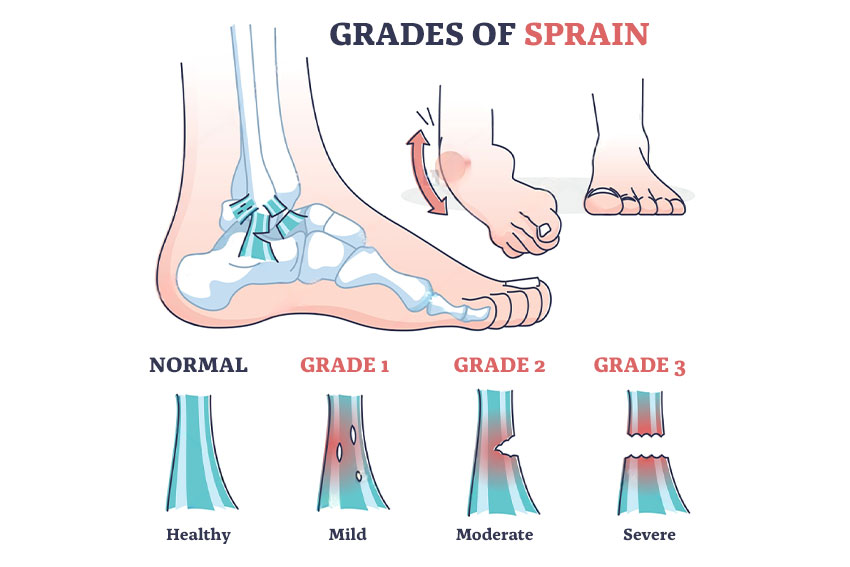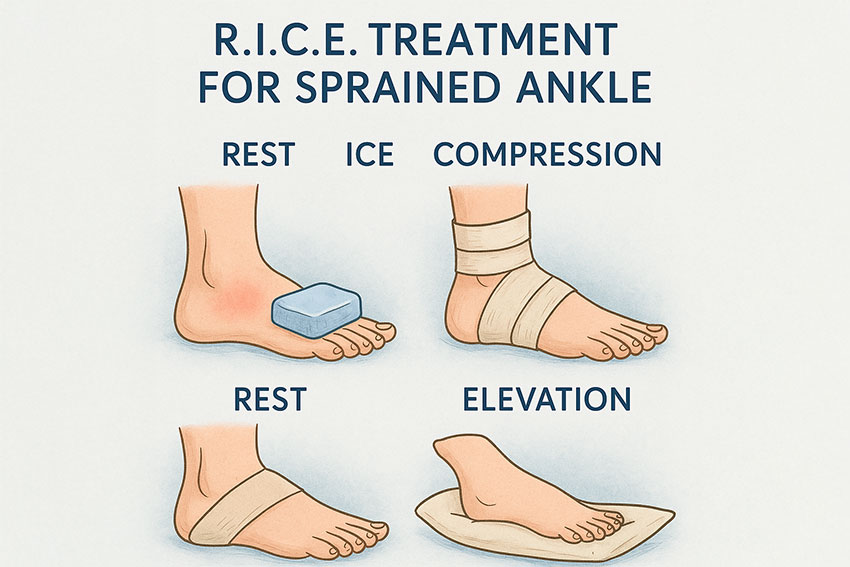
Does Walking on a Sprained Ankle Make It Worse?
A sprained ankle is a common injury that can happen to anyone, whether you’re playing sports, stepping off a curb, or simply taking a wrong step. One of the first questions that pops up is: Does walking on a sprained ankle make it worse? The answer depends on several factors, including the severity of the sprain, the amount of swelling, and how your ankle responds to pressure and movement.
In this blog, we will break down everything you need to know about sprained ankle, treatment options, recovery timelines, and best practices to support healing. If you need personalized care for your sprained ankle, Rapid Physiocare offers expert physiotherapy services to guide your recovery.
What is a Sprained Ankle?

A sprained ankle occurs when the ligaments—the tough bands of tissue that support the ankle joint—are stretched or torn. This usually happens when the ankle twists or turns unexpectedly. Common symptoms include pain, swelling, bruising, and difficulty bearing weight.
Sprains are classified into three grades:
- Grade 1 (Mild): Slight stretching of the ligament, minor swelling.
- Grade 2 (Moderate): Partial tear of the ligament, noticeable swelling and bruising.
- Grade 3 (Severe): Complete tear of the ligament, significant swelling, and instability.
People Also Read: Sprained Ankle? Here’s Your Ultimate Guide to Recovery

Can You Walk on a Sprained Ankle?
One of the most common questions after an injury is: Can you walk on a sprained ankle? The answer depends on the grade of the sprain. With a Grade 1 sprain, light walking may be okay. But with Grade 2 or 3 sprains, walking can make it worse and delay recovery.
If you’re wondering, is it bad to walk on a sprained ankle? The general rule is to avoid walking if there’s significant pain or swelling. Doing so can increase your chances of further injury or prolonged recovery. For the first 48–72 hours, focus on rest, ice, compression, and elevation (RICE) to reduce inflammation.
If you need expert guidance for managing a sprained ankle, Rapid Physiocare offers professional physiotherapy services to help with your recovery.
Does Walking on a Sprained Ankle Make It Worse?
This is a big question, especially in the early stages of healing. Yes, walking on a sprained ankle can make it worse if the injury hasn’t had time to heal properly. Putting weight on a freshly injured ankle can:
- Increased swelling and pain
- Impede healing
- Tear more ligaments
Using crutches or an ankle brace during the initial phase is often recommended to avoid unnecessary strain. For the first 48-72 hours, rest and elevation are key to reducing inflammation. Remember, your body sends pain signals for a reason. If walking hurts, stop.
Walking on a Sprained Ankle After 3 Days
After the initial rest period, people often ask, Can I walk on my sprained ankle after 3 days? If the swelling has gone down and you can bear weight without pain, short walks with support may be okay. But ease back into movement slowly.
Try using ankle support or an ankle guard for sprain recovery. Gentle range-of-motion exercises can help improve flexibility without putting too much pressure on the joint.
How Long Should I Wear an Ankle Support After a Sprain?
Wearing an ankle brace or wrap helps to stabilize the joint and prevent further injury. But how long should you wear it? That depends on your progress:
- Grade 1 sprain: 1-2 weeks
- Grade 2 sprain: 3-4 weeks
- Grade 3 sprain: Longer and possibly physiotherapy
The key is to wear it until you feel comfortable walking without pain or instability.
Effective Sprained Ankle Treatment
The best way to treat a sprained ankle is with the R.I.C.E. method:

- Rest: Don’t make it worse.
- Ice: 15-20 minutes several times a day.
- Compression: Use an elastic bandage or wrap to reduce swelling.
- Elevation: When sitting or lying down, keep the ankle above heart level.
For moderate to severe sprains, a doctor may prescribe:
- Pain medication
- Physiotherapy
- Immobilization with a boot or cast
If symptoms persist or worsen, medical evaluation is necessary to rule out fractures or torn ligaments.
How Long Does It Take to Heal a Sprained Ankle?
Another question is how long does it take to heal a sprained ankle? Recovery depends on the grade:
- Mild sprain (Grade 1): 1-2 weeks
- Moderate sprain (Grade 2): 3-6 weeks
- Severe sprain (Grade 3): 8-12 weeks or longer
Other factors like age, overall health, and how soon you start treatment also affect healing time. If you’re asking how to heal a sprained ankle fast, focus on early rest, proper care, and gradual movement. For personalized care and faster recovery, Rapid Physiocare can provide physiotherapy sessions tailored to your needs.
Ankle Support and Exercises
After the initial recovery phase, strengthening exercises help restore function. Ankle support for sprains is crucial during early mobility to prevent re-injury.
Once you feel stronger, try:
- Ankle circles
- Toe raises
- Resistance band stretches
Ankle sprain exercises are great for rebuilding strength and preventing future sprains. Avoid high-impact activities until your ankle is fully healed. Ask a physiotherapist about lower body exercises that can help you stay fit without putting strain.
How to Rehab a Sprained Ankle
Rehabbing a sprained ankle is where the real recovery begins. Here are the phases of rehab:
- Initial Phase (0-72 hours): Rest, ice, elevation, and compression.
- Subacute Phase (3-7 days): Start gentle mobility exercises.
- Recovery Phase (1-3 weeks): Strength training and balance exercises.
- Return to Activity (3+ weeks): Light jogging, then sports or workouts.
Consistency is key in rehab. If you don’t stick to the plan, you’ll prolong your recovery time and increase the risk of re-injury.
Common Mistakes to Avoid
- Ignoring pain and walking too soon
- Skipping ankle support
- Not completing rehab
- Returning to sports too early
When people ask me if walking on a sprained ankle makes it worse, my answer is always the same: yes, if you do it too early. But with the right timing and support, walking becomes part of the recovery.
Conclusion
That’s where patience comes in. A sprained ankle needs care and attention. And that means using your pain as a guide. If it hurts, you’re pushing too hard. Rest. Use ankle support to prevent re-injury. And follow a rehab plan that’s tailored to you.
To sum up:
- Walking on a sprained ankle can make it worse if done too soon.
- Always rest in the first few days.
- Use ankle support to prevent re-injury.
- Follow a rehab plan for full recovery.
At Rapid Physiocare, we tailor our services to support ankle sprain recovery. Our musculoskeletal conditions therapy addresses ligament damage and restores joint function. Manual lymphatic drainage can help with swelling and inflammation in the early stages. Shockwave therapy can be used to stimulate tissue repair and accelerate healing for more chronic or recurring ankle pain.
As you get into the recovery phase, we also offer a structured back-to-sports program to get you back to physical activity safely. Clinical Pilates can improve balance, coordination, and ankle stability – an essential part of long-term recovery and prevention.
What you need is personalized professional support to help you heal and get back to your daily routine with confidence. That’s what Rapid Physiocare provides.
Tags : can you walk on a sprained ankle, does walking on a sprained ankle make it worse, walking on a sprained ankle


